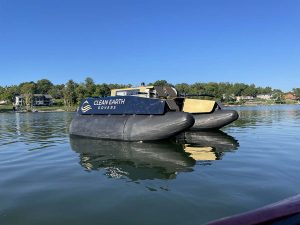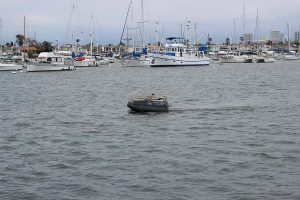
Clean Earth Rovers Revolutionize How Marinas Clean Polluted Waterways
Published on November 9, 2023While still in high school, Michael Arens, CEO of Clean Earth Rovers, was already preparing himself to be a leader in an industry that was in its infancy. During his senior year, two elements collided that launched his vision that would revolutionize how marinas deal with aquatic trash and spills.
A theology class encouraging vocations that better the world spoke to him. At the same time, a classmate gave a speech about ocean plastics. Something clicked.
“Growing up in St. Louis, that’s not something that is top of mind,” he said. “So, I was an 18-year-old hearing about this major world problem for the first time and I was really upset about it.”
Arens took that new knowledge, his passion for the environment and his drive for entrepreneurship to Xavier University in Cincinnati, Ohio. While still a student in 2019, he launched Clean Earth Rovers with a classmate who shared those same values. David Constantine is now chief operating officer.
Arens and Constantine then partnered with the 1819 Innovation Hub at the University of Cincinnati. They surrounded themselves with partners and experts who could fill skillsets needed to advance their vision.
“Originally we planned to build these massive technologies to clean the middle of the ocean,” said Arens. “Through some excellent mentoring and advising we were told to start small and get a couple of wins. That’s some of the best advice we ever received on this journey.”

The Rover is Developed
The result was a smaller technology in the Rover, an amphibious vessel that inhales trash, flotsam, and even liquid nuisances like oil and other chemicals in contained areas. Seeking stakeholders for their business, the focus became coastal communities, municipalities, and marinas that feel the pain of polluted waterways every day.
The Rover M1 is manually driven, similar to a remote-controlled car. The AVPro is fully autonomous. Upon programming, it will drive itself where it’s supposed to go and do what it’s told to do. Rovers can go from dead to fully charged in 10 hours and operate roughly 20 hours.
A follow-up to the Rover is the Data Pod, which specifically gathers information. “After talking to a lot of marinas and municipalities, we were getting an idea of what they find valuable,” said Arens. “They kept asking if our devices could monitor water quality and it was clearly something people needed beyond debris removal. Some people just need data and that’s okay.”
Launched in 2021, there are currently six Data Pod units in operation. In Florida, customers have the option to purchase a Rover outright through a distributor. At a size of just 5×5 feet, the Rover can be loaded into a pickup truck or towed with a small trailer.
In Orange County, California, they are offering regular clean-up service agreements with marinas or waterfront businesses that benefit from the appeal of clean water. With word spreading, they plan to expand to Los Angeles and San Diego areas. If customer response continues to be positive, Florida and Ohio will be next.
Gaining Traction
Six years after Arens began to dream of waterways free of trash and plastics, he is pleased with the progress they’ve made. “We have gotten a lot of people around the country – especially in the marina industry – who recognize the need for this and are really excited about it being in the water,” he said. “There is a lot of ooh and aah factors to having us around and it does spark conversation.”
Arens said the goodwill generated by people seeing their municipality or marina doing something proactive for the waterway is a benefit to the entire community. Clean water creates a better overall experience.

“We also can use Rover to do different things,” said Arens. “Like a seawall or piling inspection, like after a storm – we have a camera that allows you to DVR the feed. That’s something that in the past people didn’t have the capacity to do.”
And there is still product growth looming on the horizon. They are looking toward 2024 for an advanced version of the Data Pod to monitor organic matter – like bacteria or algae counts – in real time. While not fully new products, they are working on building an arsenal of add-ons and attachments to the existing Rover platform to optimize specific tasks.
While Arens vision of cleaning the middle of the ocean has morphed, he is happy with the direction Clean Earth Rovers is going.
“By being in harbors, ports or marinas, this is the perfect environment to intercept things,” he said. “Once the debris gets out in the ocean, it becomes like looking for a needle in a haystack.”
Providing a much-needed service to marinas and other waterfront entities scratches Aren’s itch to make the world a better place.
“Marinas and others feel and see this problem every day,” he said. “Our smaller technology provides a positive benefit to users and can do what’s needed to capture things before they become more significant problems.”
While making the areas look better, Arens said using the Rover is a good business decision for marinas.
“We can come in and give them a competitive edge,” he said. “If they are skimming by hand every day, they are losing money. Marinas really have to market premium offerings to have a competitive edge. If the water isn’t premium, it just doesn’t add up. Rovers can make the whole environment better.”
| Categories | |
| Tags |




